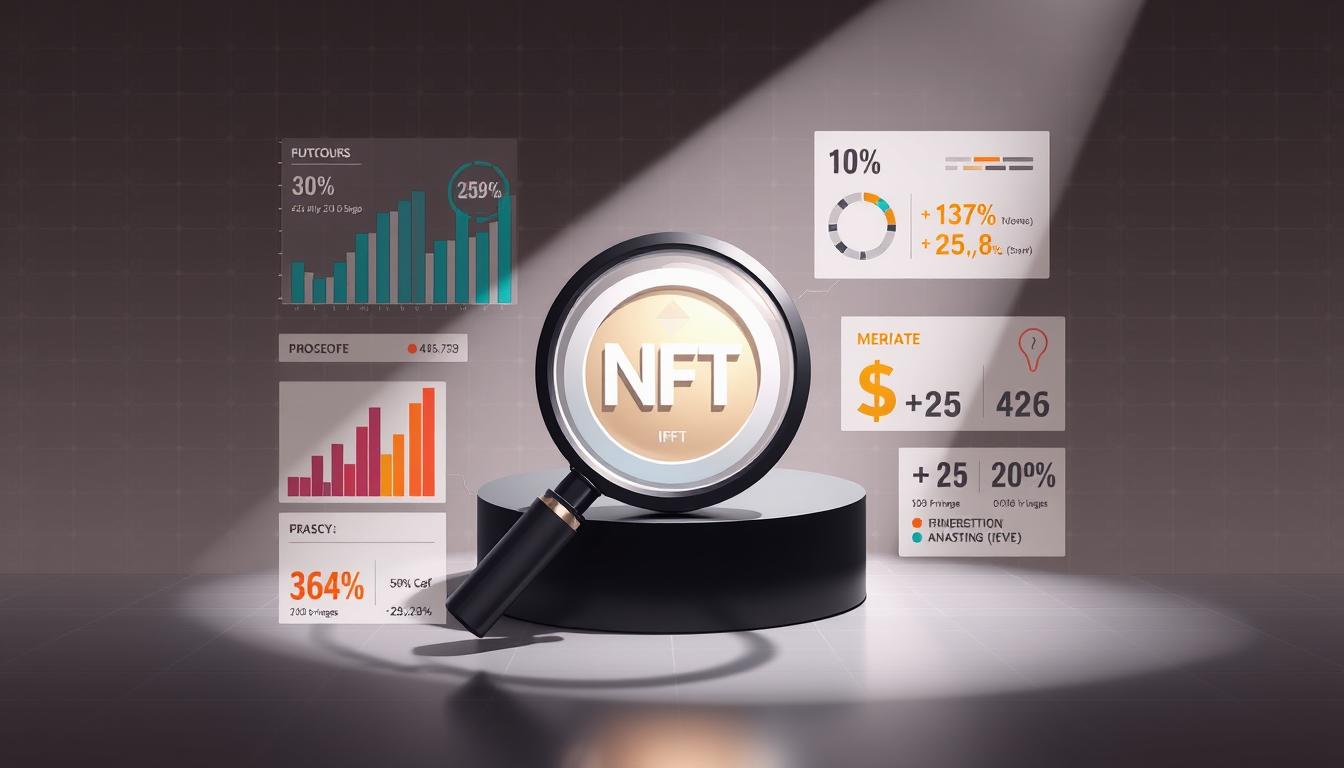Now Reading: How to evaluate NFT rarity and determine fair market value before buying
- 01
How to evaluate NFT rarity and determine fair market value before buying
How to evaluate NFT rarity and determine fair market value before buying

Digital collectibles have transformed ownership in our tech-driven era. Blockchain verification ensures each item remains unique, creating provable scarcity that drives demand. These assets range from virtual artwork to membership passes, reshaping how we perceive value in online spaces.
Rarity plays a critical role in pricing digital items. Unique traits and limited editions often command higher prices, but market trends can shift rapidly. Savvy collectors analyze multiple factors beyond surface-level features when assessing worth.
The ecosystem continues evolving with new use cases emerging regularly. From gaming assets to digital real estate, these tokens demonstrate the growing intersection of creativity and technology. Smart investors combine data analysis with market knowledge to identify promising opportunities.
Key Takeaways
- Blockchain technology authenticates digital ownership through immutable records
- Scarcity metrics directly influence collector demand and pricing
- Multiple asset categories exist beyond digital art, including utility tokens
- Effective evaluation requires combining technical analysis with market insights
- Digital ownership concepts continue expanding into new industries
Understanding NFT Rarity and Its Impact on Value
Scarcity mechanics form the backbone of valuation in tokenized assets. Each digital item’s worth stems from its unique combination of attributes and limited availability within a collection. These characteristics create measurable differences between seemingly similar assets.
Core Principles of Digital Scarcity
Rarity in blockchain-based items operates through two channels: total supply limits and distinctive features. Collections with fewer identical copies generally maintain higher demand. Specific characteristics like uncommon color schemes or accessories further differentiate individual pieces.
Case Study: Pixelated Pioneers
The CryptoPunks project demonstrates these principles effectively. Among its 10,000 characters, only 88 possess alien features. One such punk sold for $11.7 million in 2021 – nearly 3500 times rarer than standard variants. Zombie-types (24 total) and ape-themed designs (also rare) follow similar valuation patterns.
Collectors use specialized tools to analyze trait frequencies across collections. Platforms like Rarity Sniper calculate statistical probabilities for specific combinations. This data helps identify assets with hidden potential before they gain mainstream attention.
Market dynamics constantly evolve, but core scarcity principles remain stable. Savvy investors track emerging collections while monitoring established projects for undervalued pieces. Understanding these mechanics provides critical insights into digital asset valuation.
Navigating the NFT Market Landscape

Crypto markets dictate the pulse of NFT valuations, creating dynamic investment landscapes. Bitcoin’s recent 8% drop from its $124,000 peak signals shifting investor behavior, with Token Matrics analysts noting risk-off sentiment across digital assets. This volatility impacts collectible prices, as traders often liquidate speculative holdings during market downturns.
Current data reveals a 22% decline in NFT trading volumes following Bitcoin’s correction. Savvy buyers monitor these patterns to identify entry points when prices stabilize. Historical cycles suggest quality assets often rebound faster than broader markets after corrections.
Three factors now shape acquisition strategies:
- ETH/BTC ratio fluctuations influencing collector psychology
- Platform-specific volume trends signaling community confidence
- Emerging utility-focused projects weathering market shifts
Successful navigation requires balancing macro crypto trends with micro-level collection analysis. Tools like Dune Analytics track real-time sales velocity, while Discord communities provide early signals about shifting demand. Pairing these insights helps avoid emotional decisions during price swings.
The relationship between traditional crypto markets and digital collectibles remains tightly coupled. As Ethereum stabilizes above $3,400, analysts observe renewed interest in blue-chip NFT projects. Timing acquisitions during these transitional phases often yields better long-term returns.
Establishing Your NFT Investment Goals
Setting clear intentions transforms random purchases into calculated moves. A defined strategy separates casual collectors from strategic investors in digital assets. This approach minimizes emotional decisions while maximizing alignment with personal financial targets.

Identifying Short and Long-Term Objectives
Quick-turn strategies target assets with high trading volume and hype cycles. These positions require monitoring market momentum daily – think trending profile pictures or event-based drops. Platforms tracking real-time sales data become essential tools for timing entries and exits.
Long-term holdings demand different criteria. Look for projects with active developer teams and real-world utility like metaverse land deeds or gaming integrations. Communities that survive market downturns often indicate lasting value potential.
Risk profiles shape portfolio composition. Conservative investors might allocate 70% to established collections, while adventurous traders could chase emerging artists. Remember – even blue-chip assets face illiquidity risks during crypto winters.
Successful strategies balance ambition with reality. Only 23% of digital collectibles maintain value beyond six months, according to recent NFT trading strategies research. Diversification across categories and timelines helps weather market shifts.
Premium acquisitions require patience. Wait for quality assets to dip below historical averages rather than chasing hype. This disciplined approach separates sustainable growth from speculative gambles in the evolving digital economy.
Setting Up Your NFT Wallet and Funding It
Securing digital assets begins with proper wallet setup. DApp wallets like MetaMask and Coinbase Wallet act as gateways to blockchain-based ownership. These tools store cryptographic keys while interacting with decentralized platforms. Choosing the right solution balances accessibility with ironclad security protocols.

Choosing a Secure DApp Wallet
MetaMask dominates the market with 30 million monthly users, offering browser extensions and mobile apps. Its open-source code allows community audits, reducing vulnerability risks. Competitors like Coinbase Wallet appeal to crypto newcomers through simplified interfaces.
Three critical security measures every user must implement:
- Store recovery phrases offline – never digitally
- Enable two-factor authentication for wallet access
- Verify contract addresses before signing transactions
Funding Your Wallet with Ether
Ethereum remains the primary blockchain for NFT transactions. Acquiring ETH involves:
| Method | Speed | Fees |
|---|---|---|
| MetaMask Buy | Instant | 3.5-5% |
| Exchange Transfer | 5-30 mins | Network fee only |
| Peer-to-Peer | Variable | Negotiated |
Gas fees fluctuate based on network demand – early mornings (UTC) often see lower rates. Budget 10-25% above purchase prices for transaction costs. When buying digital collectibles, ensure your wallet holds sufficient ETH for both the asset and processing fees.
Test small transfers first to confirm wallet functionality. Successful setup creates a foundation for seamless participation in tokenized markets.
How to evaluate NFT rarity and determine fair market value before buying
Assessing uniqueness in tokenized items requires both data and community insight. Three core elements drive informed decisions: quantitative metrics, cultural relevance, and real-time market signals. Platforms like Rarity Tools and Trait Sniper automate calculations while providing visual dashboards for quick comparisons.
Effective analysis combines multiple evaluation techniques. Historical sales patterns reveal how specific traits perform across market cycles. For example, Bored Ape accessories showing consistent premium pricing indicate lasting demand. Simultaneously, monitoring social channels helps gauge collector enthusiasm shifts.
| Method | Focus Area | Tools | Time Required |
|---|---|---|---|
| Trait Analysis | Attribute frequency | Rarity Sniper | 15-30 mins |
| Market Comparison | Price history | NFT Price Floor | 10-20 mins |
| Community Sentiment | Social engagement | Discord/Twitter | Daily checks |
Floor prices often misrepresent true value potential. A piece priced at 2 ETH might hold hidden worth if its traits appear in only 0.5% of the collection. Cross-referencing rarity rankings with trading volume exposes these opportunities.
Seasoned collectors track liquidity patterns across marketplaces. Assets with steady bid-ask spreads typically maintain stability during downturns. This approach minimizes exposure to volatile “hype cycle” items that dominate headlines but lack staying power.
Balancing statistical models with human intuition remains critical. While algorithms calculate probabilities, cultural trends ultimately dictate desirability. Successful strategies merge these perspectives to identify assets with both mathematical rarity and crowd appeal.
Identifying Valuable NFT Traits and Collection Characteristics
Digital asset valuation hinges on understanding unique characteristics within collections. Specific traits create measurable differences between similar-looking items, often determining their long-term desirability. Platforms like OpenSea display exact percentages showing how many items share particular attributes – a critical starting point for analysis.
Breaking Down Rarity Components
Each feature contributes to an item’s overall scarcity score. In a 10,000-piece lion collection, only 200 might have an “Ice Top Knot” mane – making this 2% trait highly sought after. These percentages get converted into numerical values, creating composite rarity scores when combined.
Four elements shape effective trait evaluation:
- Statistical frequency of individual characteristics
- Visual appeal of rare features within communities
- Historical performance of similar trait combinations
- Project fundamentals like developer activity
Collections with low-supply attributes often outperform generic items during market recoveries. However, mathematically rare traits don’t always translate to higher prices – aesthetic preferences significantly influence buyer behavior. A dragon’s glowing eyes might outsell a statistically rarer tail design purely based on visual impact.
Seasoned collectors cross-reference platform data with marketplace trends. Tools like Rarity Sniper automate calculations, while Discord discussions reveal emerging preferences. This dual approach helps identify assets with both technical scarcity and crowd-approved appeal.
Assessing Fair Market Value Through Market Indicators
Market indicators act as financial compasses in digital asset trading. Savvy collectors analyze multiple data points to gauge true worth beyond surface-level prices. Two critical metrics stand out when assessing value: collection floor prices and trading volume trends.
Floor Price Mechanics
A collection’s floor price represents the minimum asking price across all available pieces. This baseline helps identify liquidity thresholds – collections with stable floors often withstand market dips better. When five items sell for 10 ETH each, the 24-hour volume hits 50 ETH. High volume signals active demand, while stagnant numbers suggest weakening interest.
Rarity-Driven Valuation
Platforms like Rarity Sniper calculate composite scores by weighing trait combinations. A lion avatar with 0.5% unique fur patterns might hold hidden value despite matching the floor price. Pair these metrics with real-time sales data to spot undervalued assets before broader recognition.
Successful strategies balance statistical insights with community sentiment. While floor prices set baselines, true market value emerges when rarity aligns with collector preferences. This dual approach transforms speculative buys into informed acquisitions.











